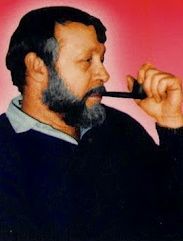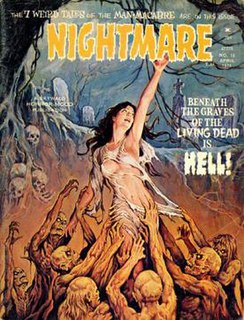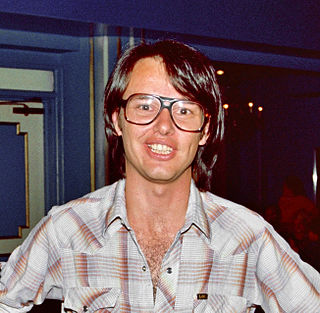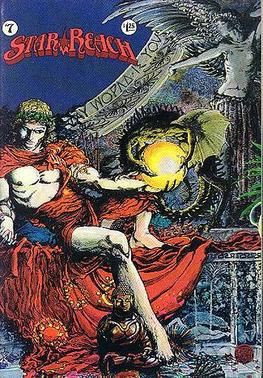
James P. Starlin is an American comics artist and writer. Beginning his career in the early 1970s, he is best known for space opera stories, for revamping the Marvel Comics characters Captain Marvel and Adam Warlock, and for creating or co-creating the Marvel characters Thanos, Drax the Destroyer, Gamora, and Shang-Chi. Later, for DC Comics, he drew many of their iconic characters, including Darkseid and other characters from Jack Kirby's Fourth World, and scripted the death of Jason Todd, the second Robin, during his run on Batman. For Epic Illustrated, he created his own character, Dreadstar.

Gerard Francis Conway is an American comic book writer, comic book editor, screenwriter, television writer, and television producer. He is known for co-creating the Marvel Comics vigilante antihero the Punisher as well as the Scarlet Spider, and the first Ms. Marvel, and also scripting the death of the character Gwen Stacy during his long run on The Amazing Spider-Man. At DC Comics, he is known for co-creating the superheroes Firestorm and Power Girl, the character Jason Todd and the villain Killer Croc, and for writing the Justice League of America for eight years. Conway wrote the first major, modern-day intercompany crossover, Superman vs. the Amazing Spider-Man.

Steve Englehart is an American writer of comic books and novels. He is best known for his work at Marvel Comics and DC Comics in the 1970s and 1980s. His pseudonyms have included John Harkness and Cliff Garnett.

Dwight Graydon "Gray" Morrow was an American illustrator of comics, magazine covers and paperback books. He is co-creator of the Marvel Comics muck-monster the Man-Thing and of DC Comics Old West vigilante El Diablo.
Douglas Moench is an American comic book writer notable for his Batman work and as the creator of Moon Knight, Deathlok, Black Mask, Electric Warrior and Six from Sirius. He is also known for his critically acclaimed eight year run on Master of Kung Fu.
Warren Publishing was an American magazine company founded by James Warren, who published his first magazines in 1957 and continued in the business for decades. Magazines published by Warren include After Hours, Creepy, Eerie, Famous Monsters of Filmland, Help!, and Vampirella.

Kurt Schaffenberger was an American comics artist. He was best known for his work on Captain Marvel and the Marvel Family during both the Golden Age and Bronze Age of comics, as well as his work on the title Superman's Girl Friend, Lois Lane during the 1950s and 1960s. Schaffenberger used the alias "Lou Wahl" on certain comics, when he was moonlighting from his main job of drawing Lois Lane at DC Comics.

Michael Golden is an American comics artist and writer best known for his late-1970s work on Marvel Comics' The Micronauts and The 'Nam, as well as his co-creation of the characters Rogue and Bucky O'Hare.

Skywald Publications was an American publisher of black-and-white comics magazines, primarily the horror anthologies Nightmare, Psycho, and Scream. It also published a small line of comic books and other genre magazines. Skywald's original comics were similar in appearance and quality to rival black-and-white publisher Warren Publishing, and even employed many of the same creators. Skwyald operated from 1970 to 1975.

Mike Friedrich is an American comic book writer and publisher best known for his work at Marvel and DC Comics, and for publishing the anthology series Star*Reach, one of the first independent comics. He is also an artists representative.

Ken Steacy is a Canadian comics artist and writer best known for his work on the NOW Comics comic book series of Astro Boy and of the Comico comic series of Jonny Quest, as well as his graphic novel collaborations with Harlan Ellison and Dean Motter. Steacy was a member of the Royal Canadian Air Cadets 386 Comox Squadron.
Howard Eugene Day was a Canadian comics artist best known for his work on Marvel Comics' Star Wars licensed series and Master of Kung Fu. He was considered a mentor by independent comic writer/artist Dave Sim.
The "DC Explosion" and "DC Implosion" were two events in 1978 – the first an official marketing campaign, the second a sardonic reference to it – in which DC Comics expanded their roster of publications, then abruptly cut it back. The DC Explosion was part of an ongoing initiative at DC to regain market share by increasing the number of titles they published, while also increasing page counts and cover prices. The so-called "DC Implosion" was the result of the publisher experiencing losses that year due to a confluence of factors, and cancelling a large number of ongoing and planned series in response. The cancellations included long-running series such as Our Fighting Forces, Showcase, and House of Secrets; new series introduced as part of the expansion such as Firestorm and Steel: The Indestructible Man; and announced series such as The Vixen which would have been the company's first title starring an African-American woman. Former flagship series Detective Comics was also considered for cancellation. Some of the material already produced for these cancelled series was used in other publications. Several of the completed stories were "published" in small quantities as two issues of Cancelled Comics Cavalcade, whose title was a reference to DC's Golden-Age Comic Cavalcade series.

John Workman is an American editor, writer, artist, designer, colorist and letterer in the comic book industry. He is known for his frequent partnerships with writer/artist Walter Simonson and also for lettering the entire run of Grant Morrison/Rachel Pollack's Doom Patrol.

Nestor P. Redondo was a Filipino comics artist best known for his work for DC Comics, Marvel Comics, and other American publishers in the 1970s and early 1980s. In his native Philippines, he is known for co-creating the superheroine Darna.

DC Special Series was an umbrella title for one-shots and special issues published by DC Comics between 1977 and 1981. Each issue featured a different character and was often in a different format than the issue before it. DC Special Series was published in four different formats: Dollar Comics, 48 page giants, digests, and treasury editions. Neither the umbrella title nor the numbering system appear on the cover; the title "DC Special Series" appeared only on the first page in the indicia. Most issues featured new material, but eight issues were reprints of previously published material.
Marvel Treasury Edition is an American comic book series published by Marvel Comics from 1974 to 1981. It usually featured reprints of previously published stories but a few issues contained new material. The series was published in an oversized 10" x 14" tabloid format and was launched with a collection of Spider-Man stories. The series concluded with the second Superman and Spider-Man intercompany crossover. Marvel also published treasuries under the titles Marvel Special Edition and Marvel Treasury Special as well as a number of one-shots.

Limited Collectors' Edition is an American comic book series published by DC Comics from 1972 to 1978. It usually featured reprints of previously published stories but a few issues contained new material. The series was published in an oversized 10" x 14" tabloid format.
Pendulum Press was a publishing company based in West Haven, Connecticut, that operated from 1970 to 1994, producing the bulk of their material in the 1970s. The company is most well known for their comic book adaptations of literary classics. The Pendulum Now Age Classics series published black-and-white paperback adaptations of more than 70 literary classics, such as Twenty Thousand Leagues Under the Sea, The War of the Worlds, and Moby-Dick. These stories were later widely reprinted by other publishers well into the 2000s. Pendulum also published a line of historical comics, a line of comic book biographies, and a line of comic book adaptations of inspiring stories and morality tales.
Eufronio Reyes Cruz is a Filipino comics artist best known for his work on mystery comics and war comics for DC Comics in the 1970s and 1980s.














